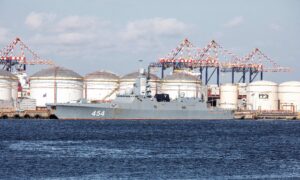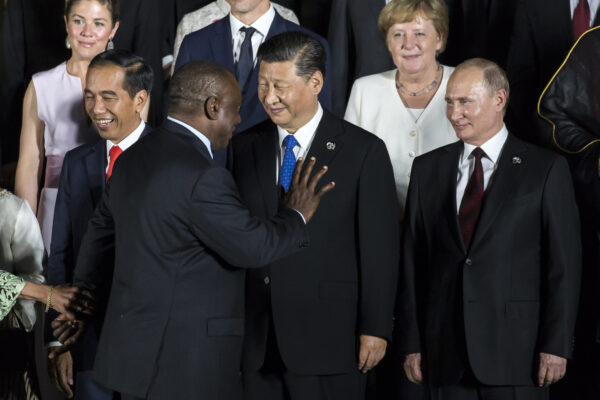South Africa Choosing Sides in China–Russia Wargames
South Africa conducts military drills with Russia and China as blocs form across the globe Commentary Combined military and naval drills between South Africa, Russia, and China began on Feb. 22. The 10-day wargames coincided with the one-year anniversary of the Russian War in Ukraine. Leading up to the start of the exercises, Russian warships docked in South Africa. The ships were marked with the letters “Z” and “V”, which have become pro-Kremlin/pro-Putin symbols of Russia’s war in Ukraine. The meanings of the letters are not entirely clear, but there is speculation that the letter “Z” means “Za pobedu” (the Russian term for “victory”), while the “V” likely stands for the “power of truth.” Allowing Russian vessels to dock in South Africa—and particularly those displaying such symbols—sends a political message that South Africa is slipping into the Chinese-Russian camp. The drills also reaffirm China’s military commitment to Russia, raising questions about the Ukraine War and the future of global politics. China’s top diplomat Wang Yi visited Moscow during the exercises. This served to reaffirm the CCP’s support for the Kremlin, while admonishing the United States for forming a bloc against Russia and China. These naval wargames are clear evidence that China is also building a bloc against the United States, NATO, and the West. The South African government justified the exercises by saying they had been scheduled long before the Russian invasion of Ukraine. However, this also raised the question of why South Africa did not cancel the joint training exercises given the current geopolitical situation. South Africa was one of 35 countries that abstained from voting to condemn the Ukraine invasion at the U.N. The country had previously allowed both a yacht owned by a sanctioned Russian individual and a Russian naval vessel to dock at their ports. South Africa’s ruling party, the African National Congress (ANC), has ties to Moscow dating back to the Cold War, when the USSR provided trainers and material support to their armed wing. Many ANC cadres were educated and received training in the former Soviet Union. South Africa, along with 119 other countries, is also a member of the Non-Aligned Movement—a forum of countries that refused to take sides during the Cold War. Together with China, India, and Brazil, South Africa and Russia are also members of the BRICS group of emerging economies. For the Kremlin, the exercises lend a certain credibility to Russia’s role in geopolitics, and show that it has some potential allies. It also sends a message to other African nations that Russia is offering an alternative to U.S. military cooperation. Given the history of European colonization in Africa, both China and Russia are happy to portray themselves as anti-colonial partners for previously oppressed countries. At the same time, Russia has repeatedly worked to undermine democracy in Africa. Moscow opposed the Arab Spring and color revolutions in North Africa. They also supported Khalifa Haftar’s attempts to install himself as ruler of Libya. In 2013, Russia supported the coup of General Abdel Fattah El-Sisi to overthrow the democratic government of Egypt. Moscow also backed military governments and coups in Sudan, Mali, Guinea, and Burkina Faso. In addition, the Russian military is providing protection for leaders in the Central African Republic, where the Kremlin is believed to have meddled in the 2020 elections. South Africa’s President Cyril Ramaphosa (2-L) waves as he walks past China’s President Xi Jinping (C) and Russian President Vladimir Putin (R) during a photo session in front of Osaka Castle at the G-20 summit in Osaka, Japan, on June 28, 2019. (Tomohiro Ohsumi/Getty Images) John Steenhuisen, the leader of South Africa’s main opposition Democratic Alliance party, told the S.A. parliament that by refusing to condemn the war, South Africa was already involved on the Russian side. The Desmond & Leah Tutu Legacy Foundation also condemned the joint exercises. The group posted a message stating “When Russia invaded Ukraine last year, and South Africa announced it would maintain a policy of neutrality, we reminded the government of Archbishop Tutu’s wisdom that if you are neutral in situations of injustice, you have chosen the side of the oppressor.” Although China and Russia try to portray the West as the enemy of democracy in Africa, the United States was one of the strongest opponents of apartheid, as it led international sanctions against the white South African government. The EU is also a far more important trading partner for South Africa than Russia. Bilateral trade between South Africa and the EU totaled $53 billion last year, while trade with Russia was a mere $750 million. For the People’s Liberation Army Navy, these exercises provide an opportunity to practice operations far from home. The drills also strengthen China’s foothold in the Indian Ocean. The PLA already has a base in Djibout

South Africa conducts military drills with Russia and China as blocs form across the globe
Commentary
Combined military and naval drills between South Africa, Russia, and China began on Feb. 22. The 10-day wargames coincided with the one-year anniversary of the Russian War in Ukraine. Leading up to the start of the exercises, Russian warships docked in South Africa. The ships were marked with the letters “Z” and “V”, which have become pro-Kremlin/pro-Putin symbols of Russia’s war in Ukraine. The meanings of the letters are not entirely clear, but there is speculation that the letter “Z” means “Za pobedu” (the Russian term for “victory”), while the “V” likely stands for the “power of truth.” Allowing Russian vessels to dock in South Africa—and particularly those displaying such symbols—sends a political message that South Africa is slipping into the Chinese-Russian camp.
The drills also reaffirm China’s military commitment to Russia, raising questions about the Ukraine War and the future of global politics. China’s top diplomat Wang Yi visited Moscow during the exercises. This served to reaffirm the CCP’s support for the Kremlin, while admonishing the United States for forming a bloc against Russia and China. These naval wargames are clear evidence that China is also building a bloc against the United States, NATO, and the West. The South African government justified the exercises by saying they had been scheduled long before the Russian invasion of Ukraine. However, this also raised the question of why South Africa did not cancel the joint training exercises given the current geopolitical situation.
South Africa was one of 35 countries that abstained from voting to condemn the Ukraine invasion at the U.N. The country had previously allowed both a yacht owned by a sanctioned Russian individual and a Russian naval vessel to dock at their ports. South Africa’s ruling party, the African National Congress (ANC), has ties to Moscow dating back to the Cold War, when the USSR provided trainers and material support to their armed wing. Many ANC cadres were educated and received training in the former Soviet Union.
South Africa, along with 119 other countries, is also a member of the Non-Aligned Movement—a forum of countries that refused to take sides during the Cold War. Together with China, India, and Brazil, South Africa and Russia are also members of the BRICS group of emerging economies.
For the Kremlin, the exercises lend a certain credibility to Russia’s role in geopolitics, and show that it has some potential allies. It also sends a message to other African nations that Russia is offering an alternative to U.S. military cooperation. Given the history of European colonization in Africa, both China and Russia are happy to portray themselves as anti-colonial partners for previously oppressed countries.
At the same time, Russia has repeatedly worked to undermine democracy in Africa. Moscow opposed the Arab Spring and color revolutions in North Africa. They also supported Khalifa Haftar’s attempts to install himself as ruler of Libya. In 2013, Russia supported the coup of General Abdel Fattah El-Sisi to overthrow the democratic government of Egypt. Moscow also backed military governments and coups in Sudan, Mali, Guinea, and Burkina Faso. In addition, the Russian military is providing protection for leaders in the Central African Republic, where the Kremlin is believed to have meddled in the 2020 elections.

John Steenhuisen, the leader of South Africa’s main opposition Democratic Alliance party, told the S.A. parliament that by refusing to condemn the war, South Africa was already involved on the Russian side. The Desmond & Leah Tutu Legacy Foundation also condemned the joint exercises. The group posted a message stating “When Russia invaded Ukraine last year, and South Africa announced it would maintain a policy of neutrality, we reminded the government of Archbishop Tutu’s wisdom that if you are neutral in situations of injustice, you have chosen the side of the oppressor.”
Although China and Russia try to portray the West as the enemy of democracy in Africa, the United States was one of the strongest opponents of apartheid, as it led international sanctions against the white South African government. The EU is also a far more important trading partner for South Africa than Russia. Bilateral trade between South Africa and the EU totaled $53 billion last year, while trade with Russia was a mere $750 million.
For the People’s Liberation Army Navy, these exercises provide an opportunity to practice operations far from home. The drills also strengthen China’s foothold in the Indian Ocean. The PLA already has a base in Djibouti, and it is building possible dual-use marine facilities in Myanmar and Sri Lanka. Furthermore, the Belt and Road Initiative includes projects in Africa, and these exercises remind participants that China may be open to similar training with other African nations. Beijing would undoubtedly welcome the opportunity to secure additional bases on the continent.
From a purely military standpoint, Russia wants these exercises to display its hypersonic missiles, which Putin claims have no equal. The Russian state news agency TASS said that the drills would include a test launch of the hypersonic “Tsirkon” missiles. TASS later reported that although the weapons would be present, they would not be test-fired.
In March, the Russian Defense Ministry claimed that they had used a Kinzhal hypersonic missile to destroy an ammunition depot in the Carpathian Mountains in western Ukraine, and again to blow up a fuel depot in Kostiantynivka near Mykolaiv. If these claims are true, they would mark the first-ever deployment of hypersonic missiles in combat.
These drills come on the heels of Putin’s suspension of the last remaining nuclear arms limitation treaty with the United States. At the same time, China’s Wang Yi was visiting Moscow and pledging closer ties with “no limits.” Furthermore, U.S. Secretary of State Antony Blinken is warning Beijing not to provide weapons to Russia. Xi Jinping is expected in Moscow soon and tensions between the West and the China-Russia alliance are expected to heighten.
Views expressed in this article are the opinions of the author and do not necessarily reflect the views of The Epoch Times.












